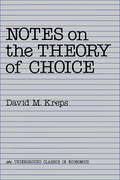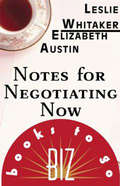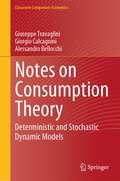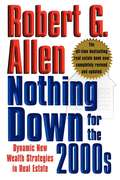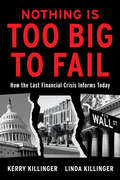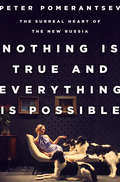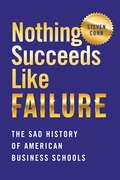- Table View
- List View
Note on the Structural Analysis of Industries
by Michael E. PorterProvides a framework for the analysis of industry structure. Identifies the major structural features that influence the profit potential in industries and some illustrative implications of these for strategy formulation. Can be used as a reference note for business policy courses and/or as the background for a lecture on industry analysis.
Note on the Theory of Optimal Capital Structure
by William E. FruhanExamines the interrelationship between the maximization of the share value of a firm's common stock and the minimization of the firm's weighted average cost of capital. Presents a revised version of a case by J.W. Mullins, Jr.
Note on the U.S. Freight Transportation Industry
by Janice H. Hammond John E.P. MorrisonDescribes the major modes of domestic freight transportation (motor carrier, rail, air, water, and pipelines). Examines the characteristics of the transportation service that each mode provides and discusses changes in the industry that have resulted from recent regulatory reform. Intended to provide background information for the transportation cases used in the Business Logistics course.
Note on the Use of Experience Curves in Competitive Decision Making
by John S. Hammond Gerald B. AllanDescribes the experience curve concept, details of its application, uses in competitive analysis, and a number of caveats and limitations.
Note on the Value of Information in an Entrepreneurial Venture
by Paul W. MarshallUses a decision analysis framework to analyze the value of gaming information before making a full investment in an entrepreneurial venture.
Note on the Venture Capital Industry
by Paul A. GompersThe history of the venture capital industry is reviewed, and the key institutional features described.
Note on the Venture Leasing Industry
by Josh LernerProvides an overview of venture leasing, an innovative financing mechanism that resembles both venture equity investments and bank lending.
Note: Credit Rating Agencies
by William E. FruhanThe note examines the role of credit rating agencies in capital markets, with emphasis on the role of these agencies in the recent credit crisis and recommendations for change.
Note: Sustaining the Commons in the 21st Century?
by Rebecca Henderson Amram Migdal Tony HeIndustry self-regulation has, in general, a lousy track record. Many studies have shown that it is often ineffective unless backed by the power of the state, and that in some cases it serves rather to forestall government intervention or to reduce competition than as genuine self-regulation. Many observers doubt that accelerated private sector regulation could really make a difference against the major public goods issues of our time. Yet we live in a time when many public goods issues are global and global governance mechanisms are at the very earliest stage of development, and in industry after industry leading firms are banding together in an attempt to regulate conduct-designing metrics, relying on independent auditors, and attempting to enforce compliance. Is this a plausible path forward? This note summarizes work in history, political science, and economics-drawing particularly on the work of Eleanor Ostrom-to explore this issue in depth.
Note: Valuing a Business Acquisition Opportunity
by William E. FruhanDescribes how to value an acquisition opportunity as a capital budgeting problem. Cash flows are discounted at the cost of capital and debt is deducted to value the equity capital of the target company. A key contribution of the note is the discussion of five methods for establishing a terminal value for future cash flows extending beyond the normal planning horizon.
Notes On The Theory Of Choice
by David KrepsIn this book, Professor Kreps presents a first course on the basic models of choice theory that underlie much of economic theory. This course, taught for several years at the Graduate School of Business, Stanford University, gives the student an introduction to the axiomatic method of economic analysis, without placing too heavy a demand on mathematical sophistication.The course begins with the basics of choice and revealed preference theory and then discusses numerical representations of ordinal preference. Models with uncertainty come next: First is von Neumann-Morgenstern utility, and then choice under uncertainty with subjective uncertainty, using the formulation of Anscombe and Aumann, and then sketching the development of Savage's classic theory. Finally, the course delves into a number of special topics, including de Finetti's theorem, modeling choice on a part of a larger problem, dynamic choice, and the empirical evidence against the classic models.
Notes for Negotiating Now: Biz Books to Go
by Leslie Whitaker Elizabeth AustinNote for Negotiating Now is a part of iPublish.com's series of short books for readers on the go. Whether you're buying a house, asking for a raise, or drawing up your divorce agreement, the internal pressure to "be a good girl" can drive you to give away more than you should, or settle for less than you deserve. Don't be embarrassed; you're not alone. Women buy half of the nation's new cars every year, yet studies show they end up paying up to 40 percent more than their male counterparts. At work, they earn 77 cents for every male dollar. And when they get home, married women do far more than their fair share of the household chores. It's not surprising that so many of us are lousy negotiators. From the time we're tiny, we're encouraged to please others and deny our own needs. But the good news for good girls is that many of us already possess an arsenal of undiscovered negotiating skills. We're great listeners, keen observers of nonverbal cues, and experts at putting ourselves in the other person's shoes. Notes for Negotiating Now will help you put those extraordinary gifts to work and equip you with the self-confidence, knowledge,
Notes of a Radiology Watcher
by Stephen R. BakerThe Radiology Department is a pivotal part of any acute and/or comprehensive health care facility. The radiologist can no longer just "hide out" there. Matters of imaging are often public concerns, larger in scope than just the scheduling and managing of a series of image tests. Rather radiology is expensive, often intrusive and in some areas earnestly and endlessly controversial. A radiologist must be attuned to these often confounding contingencies. Two recent developments in the monitoring of education of radiologists can be impacted by the content of this book. For trainees in Radiology, and for that matter, for all trainees in every medical specialty in the U. S. , a new accreditation system (NAS) has been put into place under the impetus and aegis of the ACGME, the Accreditation Committee for Graduate Medical Education, the body responsible for graduate medical evaluation and oversight in the U. S. Among its many innovations, the NAS curriculum is concerned with knowledge acquired about social and economic issues pertinent to each specialty. It is also focused on improving communication skills and about enhancing quality and safety. In the elaboration of "milestones" for residency education in these issues are codified into focused initiatives that must be addressed by each trainee as he or she advances in capability and seniority within the training interval.
Notes on Consumption Theory: Deterministic and Stochastic Dynamic Models (Classroom Companion: Economics)
by Giorgio Calcagnini Giuseppe Travaglini Alessandro BellocchiThis textbook offers a compact, yet formal, synthesis of the broad field of consumption theory. Written in a coherent and accessible way, this book introduces graduate and postgraduate students to dynamic optimization applied to consumption under certainty and uncertainty, in discrete and continuous time. Delving into deterministic and stochastic models, including the use of Brownian motions, the book offers a deeper understanding of consumption decisions and their impact on asset pricing and investment in partial and general equilibrium. This book compiles lecture notes from advanced courses in micro- and macroeconomics, ensuring a self-contained introduction to the subject. Balancing simplicity with analytical rigor, the book equips readers with essential methodological tools for advanced research in economics. With empirical evidence and exercises integrated throughout, this textbook stands as the go-to resource for scholars and students alike, fostering further theoretical explorations in the field. Basic knowledge of economics, mathematics, and econometrics is recommended for a comprehensive understanding.
Notes on the Theory of Choice
by David M. KrepsIn this book, Professor Kreps presents a first course on the basic models of choice theory that underlie much of economic theory. This course, taught for several years at the Graduate School of Business, Stanford University, gives the student an introduction to the axiomatic method of economic analysis, without placing too heavy a demand on mathematical sophistication. The course begins with the basics of choice and revealed preference theory and then discusses numerical representations of ordinal preference. Models with uncertainty come next: First is von Neumann-Morgenstern utility, and then choice under uncertainty with subjective uncertainty, using the formulation of Anscombe and Aumann, and then sketching the development of Savage’s classic theory. Finally, the course delves into a number of special topics, including de Finetti’s theorem, modeling choice on a part of a larger problem, dynamic choice, and the empirical evidence against the classic models.
Notes on the Theory of Choice
by David M. KrepsIn this book, Professor Kreps presents a first course on the basic models of choice theory that underlie much of economic theory. This course, taught for several years at the Graduate School of Business, Stanford University, gives the student an introduction to the axiomatic method of economic analysis, without placing too heavy a demand on mathematical sophistication. The course begins with the basics of choice and revealed preference theory and then discusses numerical representations of ordinal preference. Models with uncertainty come next: First is von Neumann-Morgenstern utility, and then choice under uncertainty with subjective uncertainty, using the formulation of Anscombe and Aumann, and then sketching the development of Savage’s classic theory. Finally, the course delves into a number of special topics, including de Finetti’s theorem, modeling choice on a part of a larger problem, dynamic choice, and the empirical evidence against the classic models.
Notfallvorsorge für die Wohnungswirtschaft: Risikoanalyse und Krisenprävention (essentials)
by Mario H. KrausDer Leitfaden beschreibt die Vorbeugung, Früherkennung, Eingrenzung von Gefährdungen – insbesondere Stör- und Notfällen – im Tagesgeschäft der Wohnungswirtschaft. Das Spannungsfeld wird im Zusammenhang mit der derzeitigen Rechtslage und der Siedlungsentwicklung dargestellt; dabei geht es nicht um unternehmerische Fehlleistungen oder betriebliche Mängel, sondern um schädliche Einwirkungen aus dem Umfeld.
Nothin' but Blue Skies: The Heyday, Hard Times, and Hopes of America's Industrial Heartland
by Edward McClellandThe Upper Midwest and Great Lakes region became the "arsenal of democracy"-the greatest manufacturing center in the world-in the years during and after World War II, thanks to natural advantages and a welcoming culture. Decades of unprecedented prosperity followed, memorably punctuated by riots, strikes, burning rivers, and oil embargoes. A vibrant, quintessentially American character bloomed in the region's cities, suburbs, and backwaters. <p><p> But the innovation and industry that defined the Rust Belt also helped to hasten its demise. An air conditioner invented in Upstate New York transformed the South from a sweaty backwoods to a non-unionized industrial competitor. Japan and Germany recovered from their defeat to build fuel-efficient cars in the stagnant 1970s. The tentpole factories that paid workers so well also filled the air with soot, and poisoned waters and soil. The jobs drifted elsewhere, and many of the people soon followed suit. <p><p> Nothin' but Blue Skies tells the story of how the country's industrial heartland grew, boomed, bottomed, and hopes to be reborn. Through a propulsive blend of storytelling and reportage, celebrated writer Edward McClelland delivers the rise, fall, and revival of the Rust Belt and its people.
Nothing Down for the 2000s: Dynamic New Wealth Strategies in Real Estate
by Robert G. AllenWith more than a million copies in print, Robert Allen's Nothing Down for the '90s has probably helped more people achieve success in real estate than any book in history. Countless numbers of his readers are now financially independent and many actual millionaires attribute their wealth to his techniques. Why has this blockbuster bestseller been so successful? The answer is simple: it works! Now, in one of the most practical books you'll ever read, Robert Allen has created effective new wealth strategies for investing in real estate. Real estate remains the one reliable investment in which profits can be made consistently, no matter where you live. Whether employment figures and stock prices are high or low, the real estate market never dries up -- it is one of the most dynamic income-producing vehicles ever created. The demand for housing will continue to be strong in most areas of the country for the foreseeable future. There will, of course, always be plenty of foreclosures, which are great opportunities to purchase properties cheaply. And, finally, mortgage qualification today is simpler than ever, with new mortgage packages that did not even exist twenty years ago. Nothing Down for the 2000s shows you how to locate the best buys, deal with real estate agents, and manage properties, all with little -- or no -- money down. Discover step-by-step techniques and dynamic strategies to: Use real estate to build monthly income; Finance bargain properties for equity or cash flow; Guarantee and secure your retirement; Find and profit from foreclosures before they are publicly listed; Sell and trade for maximum gain; Increase property value; Use owner financing to create opportunities; Obtain direct, legal tax cuts; Profit from conversions; Develop effective negotiation techniques, and much more. Excellent for beginners or experienced investors, Nothing Down for the 2000s is the key to generating low-risk, high-profit wealth and to a potential future of security and financial independence.
Nothing Is Missing: A Memoir of Living Boldly
by Nicole WaltersNEW YORK TIMES BESTSELLER A profound and gripping memoir by Nicole Walters, the daughter of Ghanaian immigrants who became a self-made multi-millionaire by showing others how to recognize their own strengths—and her own harrowing journey to the discovery that she was worthy all along of the life of her dreams.Nothing Is Missing is a riveting, unputdownable story of what it takes to show up for yourself—and the joy that can come once you do. Raised in a home where food was unstable and anger was the norm, Nicole learned early that she needed to take charge of her own safety and security. So she did: She got into an elite private school by talking to a stranger in her dad&’s cab, she strategized her way onto Wheel of Fortune to pay for college, she adopted three girls after meeting their mother panhandling, she quit her job to launch her own business, and she struggled. Hustling endlessly to try to achieve society&’s definition of success left her exhausted, compromising her own sense of worth in order to accommodate others. Nicole worked herself straight into a health crisis that threatened her life and the family she had worked so hard to build. It was not until she was forced into a major reckoning in both her business and her marriage that Nicole realized that she was already enough, that she had and was everything that she needed. In Nothing Is Missing, Nicole contemplates how she was able to create the life she wanted using the strength she had within herself all along.
Nothing Is Sacred: Economic Ideas for the New Millenium
by Robert J. BarroSince the 1970s, Robert Barro's academic research has significantly influenced macroeconomic theory. For more than a decade, his writing has also enlivened the pages of publications such as the Wall Street Journal and Business Week. In Nothing Is Sacred, Barro applies his well-honed free market arguments to a remarkably diverse range of issues. These include global problems such as growth and debt, as well as social issues such as the predictive value of SAT scores, drug legalization, the economics of beauty, and the relationship between abortion rights and crime reduction. The book opens with a series of essays on famous economists, past and present, and other prominent figures whose work has economic implications, including Joe DiMaggio and Bono. In the book's second part, Barro discusses the economics of social issues. In the third part, he considers democracy, growth, and international policy, and in the final part he examines fiscal policy, monetary policy, and the macroeconomy. Throughout, he shows that even the most widely held beliefs are not sacred truths but are open to analysis.
Nothing Is Too Big to Fail: How the Last Financial Crisis Informs Today
by Kerry Killinger Linda KillingerNo institution, government, or country is &“too big to fail.&” A behind-the-scenes account of what led to the 2008 crisis—and may soon lead to a bigger one. Written by two bank executives with firsthand experience of several financial crises, Nothing is Too Big to Fail holds a stiff warning about the future of finance and social justice—revealing how the US government&’s fiscal and monetary policies are creating asset and debt bubbles that could burst at any time. The COVID-19 pandemic is just one of many risks that could derail our highly leveraged and fragile economic system. The authors also tell how government actions and an unregulated shadow banking system are leading to inequitable distribution of wealth, destroying the middle class, reducing trust in government, and accelerating racial injustice. No institution, government, or country is &“too big to fail.&” This book offers lessons learned from past crises and recommended actions for business and government leaders to take today to return our economic system and our democracy to a safer trajectory.
Nothing Is True and Everything Is Possible: The Surreal Heart of the New Russia
by Peter PomerantsevIn the new Russia, even dictatorship is a reality show. <P><P>Professional killers with the souls of artists, would-be theater directors turned Kremlin puppet-masters, suicidal supermodels, Hell’s Angels who hallucinate themselves as holy warriors, and oligarch revolutionaries: welcome to the glittering, surreal heart of twenty-first-century Russia. It is a world erupting with new money and new power, changing so fast it breaks all sense of reality, home to a form of dictatorship-far subtler than twentieth-century strains-that is rapidly rising to challenge the West. <P><P>When British producer Peter Pomerantsev plunges into the booming Russian TV industry, he gains access to every nook and corrupt cranny of the country. He is brought to smoky rooms for meetings with propaganda gurus running the nerve-center of the Russian media machine, and visits Siberian mafia-towns and the salons of the international super-rich in London and the US. <P><P>As the Putin regime becomes more aggressive, Pomerantsev finds himself drawn further into the system. Dazzling yet piercingly insightful, Nothing Is True and Everything Is Possible is an unforgettable voyage into a country spinning from decadence into madness.
Nothing Succeeds Like Failure: The Sad History of American Business Schools (Histories of American Education)
by Steven ConnDo business schools actually make good on their promises of "innovative," "outside-the-box" thinking to train business leaders who will put society ahead of money-making? Do they help society by making better business leaders? No, they don't, Steven Conn asserts, and what's more they never have. In throwing down a gauntlet on the business of business schools, Conn's Nothing Succeeds Like Failure examines the frictions, conflicts, and contradictions at the heart of these enterprises and details the way business schools have failed to resolve them. Beginning with founding of the Wharton School in 1881, Conn measures these schools' aspirations against their actual accomplishments and tells the full and disappointing history of missed opportunities, unmet aspirations, and educational mistakes. Conn then poses a set of crucial questions about the role and function of American business schools. The results aren't pretty. Posing a set of crucial questions about the function of American business schools, Nothing Succeeds Like Failure is pugnacious and controversial. Deeply researched and fun to read, Nothing Succeeds Like Failure argues that the impressive façades of business school buildings resemble nothing so much as collegiate versions of Oz. Conn pulls back the curtain to reveal a story of failure to meet the expectations of the public, their missions, their graduates, and their own lofty aspirations of producing moral and ethical business leaders.

